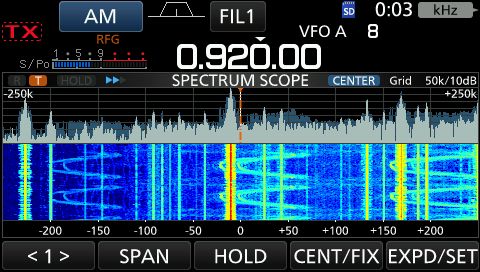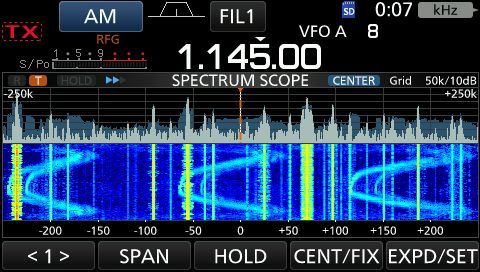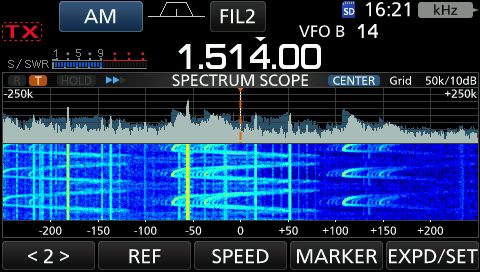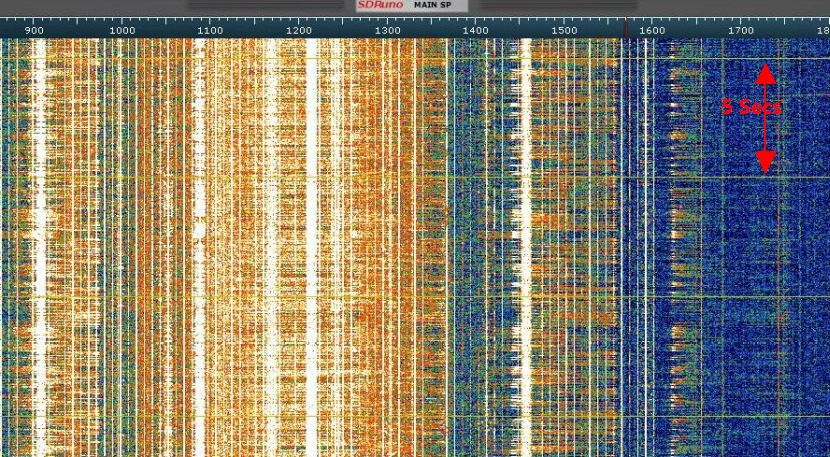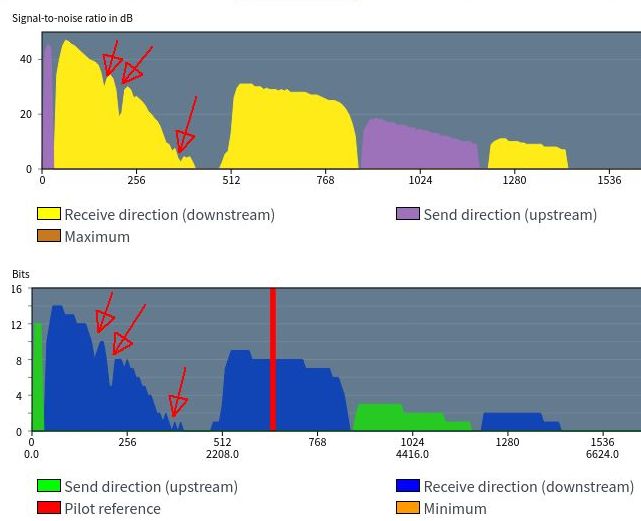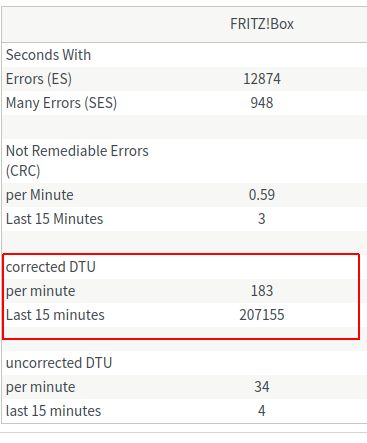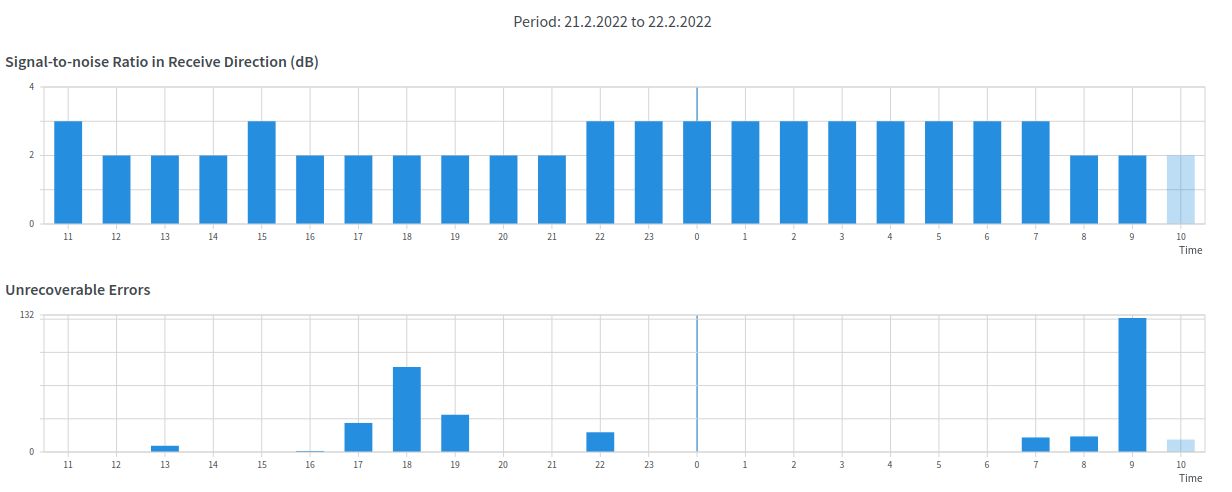Hunting Electrical Noise Sources - II
18 Feb 2022 - Jim Evans, G3VDB
Previously, I described hunting down a Switched Mode Power Supply (SMPSU) that was generating electrical noise that affected my reception of short wave radio signals. For some months, I have also been looking for another source that has much wider effects in the locality. As I began to research this post, I find that the same source has been probably been causing me problems for several years, since March 2018 or earlier. It affects not only my short wave radio but my broadband internet.
This source can easily be heard on a radio over a wide range of frequencies from 500kHz to at least 3MHz. As below, It can be seen on the waterfall spectrum of a radio, where available, in this case an ICOM IC-7300 showing a 500kHz bandwidth centred on frequencies in the Medium Wave broadcast band (500kHz - 1600kHz).
I was struck by the multiple similar signals, about 200kHz apart, sweeping back and forth over a 180kHz range, in step with each other, in what I would describe as a 'full wave rectified sine-wave'. The period of the sine wave varies from time to time - these graphs are not taken at the same time.
What is this noise source?
Multiple carriers suggest this is a high speed data transfer system such as a Power Line Transmission (PLT) device, used for Ethernet or TV video extension around a property. Since about 2010, the “approved” operational frequencies for PLTs start at 1.8MHz. Standardised PLTs should not be operating in the medium wave band. [I don’t use any PLT device and certainly would not entertain equipment working with non-standard frequencies].
By measuring the time taken for the waterfall to fill from top to bottom, the sweep time varies considerably, up to about 10 seconds in the examples shown. How can this be? What is the advantage to any data system of sweeping back and forth so slowly? It took some time to realise the true nature of what is happening. It was not until I observed the signals on a different receiver that the truth dawned. And the answer is…..
The slow sweep we are observing is not “real”; it is an artefact, a beat frequency between the real frequency shift rate of these carriers and the sampling rate of the waterfall on the ICOM IC-7300. On a Software Defined Radio with SDRUno software, the carriers look completely different. The fine horizontal lines are 5 seconds apart; the carriers are sweeping at a much higher frequency than previously thought. Even this display could give a false impression because of a higher beat frequency between the SDR software update and the true modulation of the carriers. The SDR display shows the all-pervasive spread of this particular pollution, visible in multiple bands from 880kHz to 1780kHz on this cropped display,
Interference with Broadband VDSL
The unusual feature of this source is that it is being picked up by my internet Broadband VDSL router. That is how I first noticed this signal. The carriers around 730kHz and 930kHz impact the signal-to-noise ratio (SNR) of the VDSL downstream transmission at those frequencies. My first thought was that this interference was from two broadcast stations on 693kHz and 909kHz, but they broadcast 24 hours a day; the interference is intermittent. When the interference is present, the router spectrum shows two or three significant dips in Signal to Noise Ratio. The yellow spectrum between bins 64 and about 500 is a smooth progression when the interference is absent.
There are two effects.
- The router spectrum plot (above) shows the impaired signal to noise ratio at frequencies around 700kHz and 930kHz and a resultant reduction in the number of bits represented by the carriers around those frequencies. This potentially limits the maximum stable data rate that the router can achieve.
- The router shows a very high rate of corrected errors and some uncorrected errors between the hours of 06:00 and 09:00 and between 16:00 and 22:00 on most days; it is error-free overnight and mostly error-free during the day outside those hours. The timings are different at weekends; this suggests human habits are changing the timing of the interference.
Why is that a problem?
The VDSL protocols transmit data with redundancy which allows for error correction without retransmission (known as Forward Error Correction - FEC). The DSL statistic on the left shows that these protocols are working hard when the interference is present. As shown in the bar graph below and the in the DSL stats, in the limits, these protocols fail and the end equipment experiences transmission errors. These errors necessitate re-transmissions of data.
To minimise data re-transmission (at the TCP layer) which would waste capacity in the internet, the router and VDSL central equipment negotiate a data rate where the SNR is high enough, so that the error rate is acceptably low and the line does not re-synchronise frequently, i.e. it is stable over the long term. To achieve that stability, the equipment may permanently reduce the download rate, compared to what would be achieved on an unimpaired line. There is some evidence I am losing about 10% of the potential speed.
The following bar graph from the router shows it is error-free over night and has errors morning and evening.
Questions, Questions
- What is this device?
- Where is this device?
- Exactly what times is the interference to the VDSL line occurring?
- How does the interference get into my Router?
- Direct RF pick up?
- via the Mains supply?
- Cross talk on the telephone pairs?
More work is required; I feel another write up is coming. It is at 2022-02-23-Hunting-Electrical-Noise-Sources-III.

